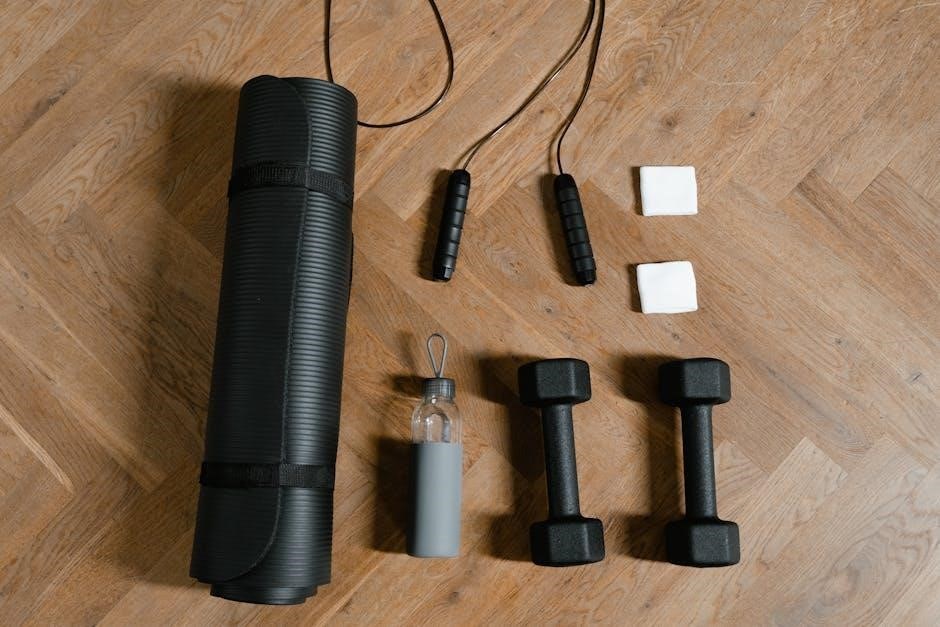Overview of a 70.3 Training Plan
A 70.3 training plan is a structured program designed to prepare athletes for a half-Ironman triathlon, focusing on building endurance, speed, and transition skills over time.
A 70.3 triathlon, also known as a half-Ironman, consists of a 1.9 km swim, 90 km bike ride, and 21.1 km run. It is a challenging endurance event that tests an athlete’s physical and mental limits. Designed for experienced triathletes, the 70.3 distance is half the length of a full Ironman, making it a significant stepping stone for those aiming to progress in the sport. The event requires a balanced approach to training, ensuring athletes build stamina, strength, and race-specific skills.
1.2 Importance of a Structured Training Plan
A structured training plan is essential for successfully completing a 70.3 triathlon. It ensures consistent progress, prevents injury, and optimizes performance by balancing swim, bike, and run workouts. A well-designed plan helps athletes build endurance, strength, and race-specific skills while allowing time for recovery. Without proper structure, athletes risk overtraining or underpreparedness, making a structured plan crucial for achieving goals and maintaining motivation throughout the training journey.
1.3 Key Components of a 70.3 Training Plan
A 70.3 training plan includes swim, bike, and run workouts, with a focus on building endurance, speed, and transition efficiency. It incorporates progressive overload, periodization, and recovery phases to avoid injury and enhance performance. The plan also emphasizes nutrition, hydration, and race-specific strategies, ensuring athletes are well-prepared for race day. Structured routines and measurable goals help track progress, making it a comprehensive approach to achieving success in a half-Ironman event;
Swim Training
Swim training is essential for building endurance, improving technique, and increasing speed in the water, laying the foundation for a strong triathlon performance.
2.1 Swim Progression for Beginners
Beginners start with short swim sessions, focusing on technique drills and gradual endurance building. Weekly swim workouts progress from 800 yards to 2,000 yards, incorporating intervals and rest periods. The plan introduces ocean or open-water acclimatization to simulate race conditions, ensuring athletes build confidence and stamina. Each week increases intensity and distance, preparing novices for the 1.9km swim leg of the 70.3 race while emphasizing consistency and proper pacing.
2.2 Sample Swim Workouts
Sample swim workouts include a warm-up with drills, followed by a main set focusing on speed and endurance. For example, 8x50m fast on 30 seconds rest, then 200m easy swimming. Cool-down involves stretching and slow laps. These structured sessions help build technique, strength, and race readiness, ensuring athletes progress steadily toward the 1.9km swim goal. Workouts vary by week, incorporating intervals and pacing exercises to enhance overall swim performance. Consistency is key to mastering the swim leg efficiently.
2.3 Building Endurance in the Water
Building endurance in swimming involves increasing distance and intensity gradually. Start with steady-paced swims of 1-2km, then progress to longer sets with intervals. Incorporate techniques like pull buoys and fins to focus on form. Endurance sessions should be done at a moderate pace, allowing for recovery between efforts. Over time, introduce open-water simulations to adapt to race conditions. Consistent practice ensures athletes can comfortably complete the 1.9km swim portion of the 70.3 race with confidence and energy to spare for the bike and run.

Bike Training
Bike training focuses on building endurance, speed, and transition efficiency. Structured sessions include steady rides, interval workouts, and brick runs to simulate race conditions effectively.
3.1 Bike Progression for a 70.3
Bike progression involves gradually increasing intensity and duration. Beginners start with base rides, building cardiovascular endurance, then introduce intervals and tempo efforts. Intermediate athletes focus on race-pace simulations and strength rides. Advanced plans incorporate high-intensity intervals and brick sessions to enhance bike-to-run transitions. Progression ensures athletes adapt safely, avoiding injury, while improving power and efficiency over time. This structured approach prepares cyclists for the demands of a 70.3 race.
3.2 Sample Bike Workouts
Sample bike workouts include a mix of endurance rides, interval training, and race-pace efforts. A typical session might involve a 40-minute moderate ride with 4×30-second sprints, followed by recovery periods. Another workout could feature a 60-minute base ride with three 15-minute race-pace segments. Brick sessions, combining bike and run, are also essential. These workouts aim to build stamina, speed, and transition efficiency, ensuring athletes are race-ready. They progress in intensity and duration as the training plan advances.
3.3 Incorporating Brick Sessions
Brick sessions are crucial for simulating race-day transitions, combining bike and run workouts. A typical brick involves a 15-minute bike ride followed by a 10-minute run. These sessions improve transition efficiency and reduce fatigue. As the training plan progresses, bricks increase in duration and intensity, with longer bike segments and faster-paced runs. Incorporating bricks helps athletes adapt to the physical and mental demands of back-to-back disciplines, enhancing overall race readiness and performance.

Run Training
Run training for a 70.3 focuses on building endurance, speed, and race pace. It progresses from foundational miles to specific workouts, ensuring consistency and periodization for optimal performance.
4.1 Run Progression for a 70.3
Run progression for a 70.3 begins with building a foundational endurance base through consistent mileage and gradual increases in intensity. Early phases focus on establishing a weekly routine, incorporating long slow distance runs, and introducing speed workouts like intervals and tempo runs. As the training plan progresses, race-specific workouts are added, such as brick sessions combining bike and run, and race pace practice to simulate competition conditions. Periodization ensures peak performance at race time, with a taper phase to allow recovery and optimization.
4.2 Sample Run Workouts
Sample run workouts for a 70.3 training plan include:
- Interval Training: 6-8 x 800m at race pace with 400m active recovery.
- Tempo Run: 20-minute warm-up, 30-minute steady-state effort at threshold pace, 15-minute cool-down.
- Long Slow Distance (LSD): 90-120 minutes at conversational pace to build endurance.
- Brick Session: 60-minute bike ride followed by a 30-minute run to simulate race transitions.
These workouts are designed to improve speed, endurance, and race-specific skills. Always include a warm-up and cool-down for optimal performance and recovery.
4.3 Race Pace Practice
Race pace practice is crucial for building confidence and stamina. Incorporate tempo runs and interval workouts to simulate race conditions. Start with shorter intervals at race pace, gradually increasing duration. Incorporate brick sessions to practice transitions from bike to run. Consistency in pacing helps develop mental toughness and physical endurance, ensuring you can maintain speed over the 13.1-mile distance. Periodically test race pace during long runs to assess progress and adjust training accordingly.

Sample 20-Week Novice Training Plan
A 20-week novice plan progressively builds endurance, starting with foundational workouts in swim, bike, and run. It includes structured sessions to ensure steady improvement and consistency.
5.1 Weekly Structure
The weekly structure balances swim, bike, and run sessions, with rest days to allow recovery. Each week includes three swims, three rides, and three runs, increasing in intensity and duration progressively. Brick sessions are incorporated to simulate race transitions. The plan also integrates strength training and flexibility exercises to enhance overall performance and prevent injuries. This balanced approach ensures athletes build endurance and race-specific skills without overtraining, keeping them motivated and on track for race day.
5.2 Progression Over 20 Weeks
The 20-week plan progresses from base building to race-specific preparation. Weeks 1-4 focus on endurance with low-intensity workouts. Weeks 5-8 introduce speed and strength training. Weeks 9-12 emphasize race pace and brick sessions. Weeks 13-16 increase intensity and simulate race conditions. Weeks 17-20 taper to allow recovery and peak fitness. This periodized approach ensures gradual improvement, injury prevention, and optimal race readiness. Each phase builds on the previous, preparing athletes for the demands of the 70.3 distance.
Sample 16-Week Intermediate Training Plan
This 16-week plan balances swim, bike, and run workouts, increasing intensity and endurance progressively. It includes three swims, rides, and runs per week, focusing on race preparation and simulation.
6.1 Balancing Swim, Bike, and Run
Balancing swim, bike, and run in a 16-week intermediate plan ensures well-rounded development. Each week features three swims, rides, and runs, with one or two brick sessions. Workouts are structured to avoid overtraining, with rest days and recovery included. The plan prioritizes consistency, gradually increasing intensity and volume while allowing for adaptation and progress. This balanced approach helps build endurance, speed, and transition efficiency, preparing athletes for race demands effectively and safely.
6.2 Increasing Intensity
The intermediate plan gradually increases intensity through targeted workouts. Bike sessions include sprint intervals, swims focus on fast repeats, and runs emphasize threshold pacing. These increases are balanced with recovery periods to optimize performance gains without overtraining. The structured approach ensures athletes build both speed and endurance, preparing them for the demands of a 70.3 race while minimizing the risk of injury or burnout.
Sample 6-Month Advanced Training Plan
A 6-month advanced training plan for 70.3 triathlons, designed for experienced athletes, includes structured swim, bike, and run phases, with downloadable PDF guides for detailed planning.
7.1 Building a Strong Base
Building a strong base is crucial in a 6-month advanced 70.3 training plan. This phase focuses on establishing endurance, strength, and consistency across all three disciplines. Athletes engage in high-volume, low-intensity workouts to enhance aerobic capacity and muscular endurance. Swim sessions emphasize long-distance sets, cycling includes endurance rides, and running incorporates tempo runs. This period also introduces strength training to prevent injuries and improve overall performance. A well-structured base phase ensures athletes are prepared for the intensity of later stages. Proper nutrition, recovery, and periodization are emphasized to maximize progress and avoid burnout.
7.2 Periodized Training Phases
Periodized training phases in a 6-month advanced plan involve dividing the program into specific blocks, each targeting different fitness goals. The initial phase focuses on building foundational endurance, followed by a strength and intensity phase. Race-specific preparation comes next, with workouts mimicking race conditions. Finally, a taper phase reduces volume to ensure peak performance on race day. This structured approach ensures progressive overload, recovery, and adaptation, leading to optimal race readiness while minimizing injury risk.

Nutritional and Recovery Strategies
Nutritional planning ensures proper fueling for workouts and recovery. Strategies include balanced diets, hydration, and post-workout nutrition. Recovery techniques like stretching, foam rolling, and sleep optimize performance and reduce injury risk.
8.1 Fueling for Workouts
Fueling for workouts is critical to sustain energy levels and optimize performance. A balanced diet rich in carbohydrates, proteins, and fats provides essential energy. Hydration is key, with electrolytes replenishing lost salts. Pre-workout meals should be light and easily digestible, while post-workout nutrition aids recovery. Timing and portion control are personalized to individual needs and training intensity. Proper fueling strategies ensure athletes maintain endurance, avoid bonking, and recover efficiently for subsequent sessions.
8.2 Recovery Techniques
Recovery techniques are vital for optimizing performance and preventing injury. Incorporate stretching, foam rolling, and massage to reduce muscle tension. Prioritize hydration and nutrition, consuming a recovery shake with carbohydrates and protein within 30 minutes post-workout. Ensure adequate sleep, aiming for 7-9 hours nightly, to aid muscle repair and mental recovery. Active recovery, such as light swimming or cycling, enhances blood flow without overexertion; Consistency in these practices supports overall training adaptation and enhances race readiness.

Race Strategy and Pacing
Developing a race strategy involves understanding race dynamics, balancing swim, bike, and run efforts, and managing transitions efficiently. Practicing race-pace segments in training ensures sustainability on race day.
9.1 Understanding Race Dynamics
Understanding race dynamics is crucial for a successful 70.3 finish. It involves analyzing the course, weather conditions, and competition level. Athletes should study the terrain to optimize pacing strategies, ensuring they conserve energy for critical sections like climbs or technical parts. Weather factors such as wind or heat can significantly impact performance, requiring adjustments in hydration and nutrition plans. Additionally, knowing the competition helps in setting realistic goals and maintaining mental focus throughout the race.
9.2 Transition Tips
Mastering transitions is key to a seamless 70.3 race. Practice T1 and T2 during training to minimize time lost. Lay out gear in a logical order, with cycling shoes clipped to the bike and running shoes easily accessible. Use a race belt to save time with the run bib. Stay calm and focused, avoiding unnecessary delays. Effective transitions can shave valuable minutes off your total race time, giving you a competitive edge.
Completing a 70.3 training plan requires dedication and consistency. Proper preparation, mental readiness, and final checks ensure a strong race day performance and a fulfilling finish.
10.1 Final Preparations
Final preparations for a 70.3 race involve equipment checks, tapering training, and mental readiness. Ensure your bike is serviced, and gear is race-ready. Review nutrition plans and practice transitions. Rest and recovery are crucial in the last two weeks. Visualize the race and stay positive. Pack essentials like race attire, snacks, and hydration. Arrive early to familiarize yourself with the course. Stay calm and trust your training—everything else will fall into place on race day.
10.2 Mental Readiness
Mental readiness is crucial for a successful 70.3 race. Techniques like visualization, positive affirmations, and mindfulness help build resilience. Focus on breaking the race into manageable segments and embracing challenges. Practice staying calm under pressure and remind yourself of your training achievements. A strong mental game will help you push through fatigue and maintain race pace. Confidence and focus are key to overcoming doubts and crossing the finish line strong.